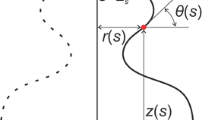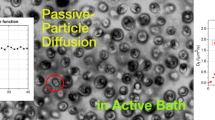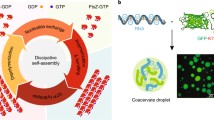Summary
It is proposed as a working hypothesis that conformational changes propagated like waves along intracellular fibrils (tubules, microtubules, microfilaments) have an electric component,i.e., there are waves of disturbance of electric potential in the fibrils. The paper considers the unavoidable consequences of the wave. The latter is accompanied by local electric field in the boundary layer of cytoplasmic fluid. Both positively and negatively charged particles may be attracted to the fibril in certain regions of the field and, being attracted, the particle may be under the action of longitudinal component of electric force. When the force is strong enough to move the particle with wave velocity, the particle will travel smoothly along the fibril, otherwise the movement will be saltatory or of agitation type. Net electroosmotic flow in one direction in the boundary layer of fluid may be expected when the waves are propagated in series. Turbulent motion of the fluid caused by the waves may provide the basis for activated diffusion. Asymmetry of the wave may account for polar transport of this sort. The electric field transmitted along the fibril across a sieve pore in phloem may facilitate electroosmotically the flow through the pore. Quantitative requirements of the hypothesis that electric field generated by the waves may account for different aspects of longitudinal transport in cells are apparently met.
Similar content being viewed by others
References
Allen, R. D., 1964: Cytoplasmic streaming and locomotion in marineForaminifera. Primitive Motile Systems in Cell Biology (R. D. Allen andN. Kamiya, eds.), 407–432. New York: Acad. Press.
Ambrose, E. J., 1965: Cell movements. Endeavour91, 27–32.
Behnke, H. D., 1969: Über den Feinbau und die Ausbreitung der Siebröhren-Plasmafilamente und über Bau und Differenzierung der Siebporen bei einigen Monocotylen und beiNuphar. Protoplasma68, 377–402.
Byers, B., andD. H. Abramson, 1968: Cytokinesis in HeLa: Post-telophase delay and microtubule-associated motility. Protoplasma66, 413–435.
Canny, M. J., 1962: The mechanism of translocation. Ann. Bot., N.S.,26, 603–617.
—, andO. M. Philips, 1963: Quantitative aspects of a theory of translocation. Ann. Bot., N.S.,27, 379–402.
Cronshaw, J., andK. Esau, 1968: Cell division in leaves ofNicotiana. Protoplasma65, 1–24.
— —, 1968: Protein in the phloem ofCucurbita II. The P protein of mature sieve elements. J. Cell Biol.38, 292–303.
Fensom, D. S., 1957: The bioelectric potentials and their functional significance I. An electrokinetic theory of transport. Canad. J. Bot.35, 573–582.
Hayashi, T., 1964: Role of the cortical gel layer in cytoplasmic streaming. Primitive Motile Systems in Cell Biology (R. D. Allen andN. Kamiya, eds.), 19–29. New York: Acad. Press.
Helder, R. J., 1967: Translocation inVallisneria spiralis. Encyclopedia of Plant Physiol. (W. Ruhland, ed.)XIII, 20–43. Berlin: Springer-Verlag.
Jarosch, R., 1956: Plasmaströmung und Chloroplastenrotation bei Characeen. Phyton (Argentina)6, 87–107.
—, 1964: Screw-mechanical basis of protoplasmic movement. Primitive Motile Systems in Cell Biology (R. D. Allen andN. Kamiya, eds.), 559–622. New York: Acad. Press.
Johnson, F. H., H. Eyring, andM. J. Polisar, 1954: The kinetic basis of molecular biology. Chapters 11 and 12. New York: J. Wiley & Sons.
Johnson, R. R. C., 1968: Microfilaments in pores between frozen-etched sieve elements. Planta81, 314–332.
Kamiya, N., 1959: Protoplasmic streaming. ProtoplasmatologiaVIII/3 a. Wien: Springer-Verlag.
—, 1962: Protoplasmic streaming. Encyclopedia of Plant Physiology (W. Ruhland, ed.)XVII/2, 979–1035. Berlin: Springer-Verlag.
Kavanau, J. L., 1965: Structure and function in biological membranesII. San Francisco: Holden-Day, Inc.
Kishimoto, U., andH. Akabori, 1959: Protoplasmic streaming of an internodal cell ofNitella flexilis. Its correlation with electric stimulus. J. Gen. Physiol.42, 1167–1183.
Kuroda, K., 1964: Behavior of naked cytoplasmic drops isolated from plant cells. Primitive Motile Systems in Cell Biology (R. D. Allen andN. Kamiya, eds.), 31–41. New York: Acad. Press.
Lorente de Nó, R., 1947: A study of nerve physiology. Chapter XVI. Studies from the Rockefeller Institute for Medical Research132, 384–477.
Mahlberg, P. G., 1964: Rates of organelle movement in streaming cytoplasm of plant tissue culture cells. Primitive Motile Systems in Cell Biology (R. D. Allen andN. Kamiya, eds.), 43–68. New York: Acad. Press.
Mitchell, P., 1961: Approaches to the analysis of specific membrane transport. Biological Structure and Function (T. W. Goodwin andO. Lindberg, eds.)II, 581–604. London: Acad. Press.
—, 1966: Chemiosmotic coupling in oxidative and photosynthetic phosphorylation. Biolog. Rev.41, 445–502.
Mishra, M., andD. C. Spanner, 1970: The fine structure of the sieve tubes ofSalix caprea L. and its relation to the electroosmotic theory. Planta90, 43–56.
Mueller, P., andD. D. Rudin, 1963: Induced excitability in reconstituted cell membrane structure. J. Theor. Biol.4, 268–280.
— —, 1968: Action potential induced in biomolecular lipid membranes. Nature217, 713–719.
Nagai, R., andL. I. Rebhun, 1966: Cytoplasmic microfilaments in streamingNitella cells. J. Ultrastruct. Res.14, 571–589.
Rebhun, L. I., 1967: Structural aspects of saltatory particle movement. J. Gen. Physiol.50, 223–239.
Rinaldi, R. A., andT. L. Jahn, 1964: Shadowgraphs of protoplasmic movement inAllogromia laticollaris and a correlation of this movement to striated muscle contraction. Protoplasma58, 369–390.
Rosenfalck, P., 1969: Intra- and extracellular potential fields of active nerve and muscle fibres. Acta Physiologica Scandinavica, Suppl. 321.
Roth, L. E., D. J. Pihlaja, andY. Shigenaka, 1970: Microtubules in Heliozoan axopodium I. The gradion hypothesis of allosterism in structural proteins. J. Ultrastruct. Res.30, 7–37.
—, andJ. Chakraborty, 1966: Anaphase structure in mitotic cells typified by spindle elongation. J. Ultrastruct. Res.14, 460–483.
Schmitt, F. O., 1968: Fibrous proteins—neuronal organelles. Proc. Nat. Acad. Sci. (U.S.A.)60, 1092–1101.
Seifriz, I. W., 1952: The rheological properties of protoplasm. Deformation and Flow in Biological Systems (A. Frey-Wyssling, ed.), 2–156. Amsterdam: N. Holland Publ. Comp.
Seifriz, I. W., 1953: Mechanism of protoplasmic movement. Nature171, 1136–1138.
Shashoua, V. E., 1967: Electrically active polyelectrolyte membranes. Nature215, 846–847.
Spanner, D. C., 1958: The translocation of sugar in sieve tubes. J. Exp. Bot.9, 332–342.
Thaine, R., 1962: A translocation hypothesis based on the structure of plant cytoplasm. J. Exp. Bot.13, 152–160.
—, 1965: Surface associations between particles and the endoplasmic reticulum in protoplasmic streaming. New Phytol.64, 118–130.
Thornburg, W., 1967: Mechanism of biological motility. Theoretical and Experimental Biophysics (A. Cole, ed.). London: E. Arnold Publishers Ltd.
Umrath, K., 1933: Der Erregungsvorgang beiNitella mucronata. Protoplasma17, 258–300.
Weatherley, P. E., A. J. Peel, andG. P. Hill, 1959: The physiology of the sieve tube. J. Exp. Bot.10, 1–16.
Wohlfarth-Bottermann, K. E., 1961: Cytologische Studien VIII. Zum Mechanismus der Cytoplasmaströmung in dünnen Fäden. Protoplasma54, 1–26.
Wooding, F. B. P., 1967: Fine structure and development of phloem sieve tube content. Protoplasma64, 315–324.
Zimmermann, M. H., 1969: Translocation velocity and specific mass transfer in the sieve tubes ofFraxinus americana L. Planta84, 272–278.
Author information
Authors and Affiliations
Rights and permissions
About this article
Cite this article
Hejnowicz, Z. Propagated disturbances of transverse potential gradient in intracellular fibrils as the source of motive forces for longitudinal transport in cells. Protoplasma 71, 343–364 (1970). https://doi.org/10.1007/BF01279681
Received:
Issue Date:
DOI: https://doi.org/10.1007/BF01279681




